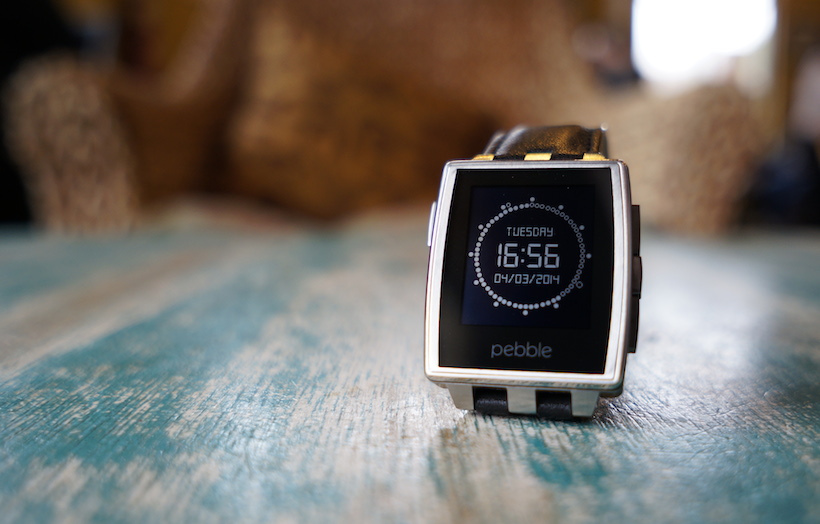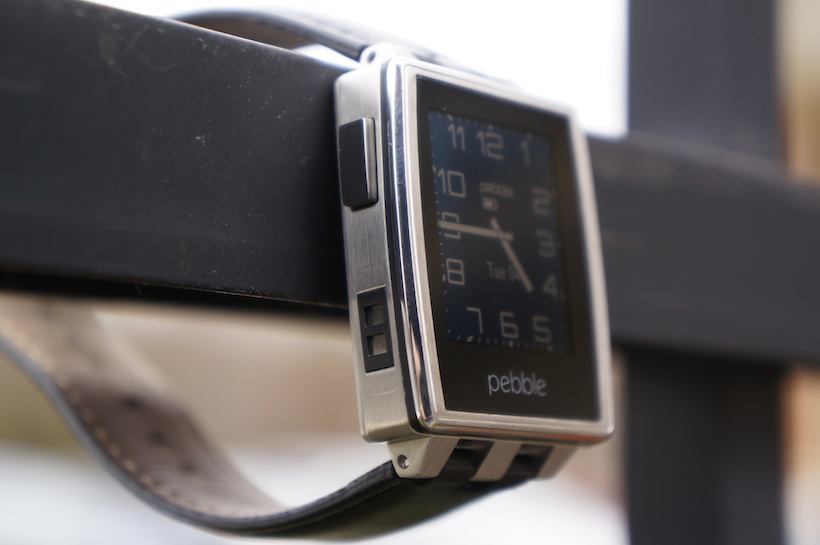I was minutes from publishing a speculation article about the rumored Google smartwatch when Google announced its brand new wearables platform, Android Wear. Then Motorola and LG followed suit, announcing the Moto 360 and G Watch, respectively.
Minutes from publishing, I had to rewrite the entire article. I changed the angle from a purely speculative piece about all the rumors we’d heard and whether they were credible or not to a piece about how Google and Motorola made me regret my $250 purchase of Pebble Steel.
Sure, it was a reactionary, knee-jerk piece, but it was true. The one thing I’ve been craving on my wristsince I got Pebble was a solid Google Now experience. You can sync Google Now notifications to your wrist on Pebble using the third-party app Pebble Notifier, but it’s incessant and annoying.
I wanted Google voice searches on my wrist, cards that tell me how far I am from home or what the weather is, and my watch to learn and know more about me the more I use it.
Pebble doesn’t offer most of that. You can install an app through Pebble appstore that will pull weather, or even a watchface with current conditions on it. But there’s no microphone, no color display, no touchscreen, and no seamless Google Now integration.
And you know what? That’s fine. Pebble was never intended to be used like that. It was supposed to be subtle, simple, and solid in use. And I can’t complain because it’s lived up to everything it was ever supposed to be, though the battery life has admittedly took a tumble for a while.
My Pebble Steel arrived a few weeks later (after a $25 discount for all the delays) and I’ve worn it every day since. And I’ve been happy with it. Very happy. So happy, I’m not 100 percent sure I’ll get rid of it after the Moto 360 hits shelves. I may not use it, but I don’t want to get rid of it.
There’s something different about Pebble. It’s a rowdy upstart that’s hellbent on playing ball with much larger entities like Samsung, Sony, Google, Motorola, LG, and, eventually, Apple. It’s doing quite well for itself, despite all the adversity. But we mustn’t forget Android Wear has only been available to the public for a few weeks now, and the startup has its work cut out for it, especially if it wants to remain a serious player in what is turning out to be a vicious and increasingly competitive market.
Just hours after the Android Wear announcement, Pebble CEO Eric Migicovsky spoke up, expressing his excitement. In a statement to TechCrunch, he said:
“We’re excited about today’s news from our friends at Google. When we started working on wearables six years ago, there were few players in the space and a lot of skeptics. It’s exciting to see this market grow so quickly — enabling more interesting use cases and keeping all of us laser-focused on creating the very best user experiences we can.”
Still, there has been a lot of skepticism about the future of Pebble and how it will cope with the inevitable onslaught of Android Wear devices and the rumored iWatch. As expected, many have suggested Pebble’s only hope at staying afloat is to give in and create an Android Wear watch.
Just this last week, we fielded a question about an Android Wear-powered Pebble on the Pocketnow Weekly 104. And while I, like many of you, would love to see what Pebble could do with Android Wear, it doesn’t make a lot of sense for the company.
For starters, you have to understand Pebble is not Samsung, Sony, or LG. Pebble is not a company that has been around for decades. Pebble doesn’t have its hand in all areas of the consumer electronic market. It’s a company that was seeking crowd funding just two years ago to start to make its first watch. And while that Kickstarter campaign was the most successful of all time, it still isn’t poised to experiment too much with new operating systems.
That’s not to say Pebble isn’t doing incredibly well. Since it started fulfilling its 85,000 Kickstarter backer orders, Pebble has sold 400,000 units. Only two million smartwatches were sold in all of 2013. Not all of those 400,000 Pebbles were sold last year, but it still means Pebble held a significant chunk of the smartwatch market share in 2013.
Financial matters aside, there are still more reasons Pebble shouldn’t take on Android Wear.
It has spent thousands of man-hours creating a simple OS from the ground up – Pebble OS. While it may not be in color or have support for higher-resolution displays yet, it’s older and more well-rounded than other wearable operating systems. For instance, it has notification history, something you won’t find on Android Wear. You know what else Pebble has that you won’t find on Android Wear (at least for now)? Support for iOS.

It also has thousands of third-party applications made specifically for Pebble smartwatches.
Truthfully, that’s the biggest reason Pebble needs to simply keep doing what it’s doing. Pebble OS comes alongside the Pebble appstore, which has over 3,200 applications and 15,000 registered developers. It has a very strong and thriving development community.
 Moving over to Android Wear doesn’t mean Pebble would abandon its existing developers. It could very well keep two product lines alive, like HTC and Samsung (sort of) do with Android and Windows Phone. But that would also mean Pebble OS wouldn’t get the company’s undivided attention. It would be developing hardware for two platforms. And a small (and rapidly growing company) would be forced to grow and expand faster, all on the whim of a new and still very beta-esque operating system.
Moving over to Android Wear doesn’t mean Pebble would abandon its existing developers. It could very well keep two product lines alive, like HTC and Samsung (sort of) do with Android and Windows Phone. But that would also mean Pebble OS wouldn’t get the company’s undivided attention. It would be developing hardware for two platforms. And a small (and rapidly growing company) would be forced to grow and expand faster, all on the whim of a new and still very beta-esque operating system.
It isn’t impossible, and I’m not saying I wouldn’t love to see Pebble take a stab at Android Wear. Quite the opposite, really. I’d be one happy dude if I could get the full Google Now experience on something as nice as Pebble Steel.
Maybe someday we’ll see what that’s like. But for now, it simply doesn’t make sense, and I’d rather see Pebble put 100 percent of its efforts into its own, in-house products than to see it fragment so early on.
The upshot here is that Android Wear may have just forced Pebble to kick into overdrive and bring new features. That, for me, is very exciting.



No comments:
Post a Comment